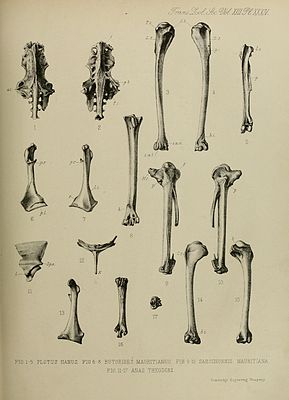Mauritius duck
| Mauritius duck | ||||||||||||
|---|---|---|---|---|---|---|---|---|---|---|---|---|

Type material of the Mauritius duck |
||||||||||||
| Systematics | ||||||||||||
|
||||||||||||
| Scientific name | ||||||||||||
| Anas theodori | ||||||||||||
| Newton & Gadow , 1893 |
The Mauritius duck ( Anas theodori ) is an extinct species of duck that was found on Mauritius and probably also on Réunion . The type epithet honors the French naturalist Théodore Sauzier , who discovered the subfossil remains in the Mare aux Songes fossil site. The type material consists of a sternum fragment , two coracoids , eight humerus and two tarsometatarsi , which are in poor condition. All bones of this kind significantly larger than the corresponding bones of the African Pygmy Goose ( Nettapus auripus ) of Bernier's Teal ( Anas bernieri ) and the wandering whistling duck ( Dendrocygna arcuata ), but shorter than the bones of Madagascar duck ( Anas melleri ). The sternum ridge is shorter than that of the wandering whistle goose and the Madagascar duck. The length of the coracoid is 42 mm and that of the humerus varies between 70 and 78 mm. The right tarsometatarsus measures 42 mm and suggests that the Mauritius duck had smaller feet than the Madagascar duck. Later excavations on Mauritius and Réunion unearthed additional sternum bones, tarsometatarsi, a carpometacarpus and a skull fragment .
There are few historical records relating to the Mauritius duck. The Mauritian governor Issac Johannes Lamotius reported in 1681 that large numbers of flamingos, ducks and geese were found on the ponds in the forests. In 1693, François Leguat described the Mauritius duck as rare. In 1696 Lamotius' successor Roelof Deodati mentioned ducks in Mauritius for the last time. There are also various reports of ducks on Réunion, which presumably represented this species. In 1710, Antoine Desforges-Boucher, Governor of Réunion from 1723 to 1725, wrote that of the once countless flamingos, pigeons, moorhens, geese, ducks, larks, snipes, thrushes, lapwing and ravens, only a small remainder of the insatiable greed of the settlers had escaped .
literature
- Anthony William Diamond: Studies Of Mascarene Island Birds . Cambridge University Press, 1987 (reprinted 2009). ISBN 978-0-521-11331-1
- Edward Newton & Hans Friedrich Gadow (1893): On additional bones of the Dodo and other extinct birds of Mauritius obtained by Mr. Théodore Sauzier . Trans. Zool. Soc. 13: pp. 281-302
- Walter Rothschild (1907): Extinct Birds
- Masauji Hachisuka (1953): The dodo and kindred birds, or, The extinct birds of the Mascarene Islands. London: HF & G. Witherby, 250 pp.
- Anthony Cheke & Julian Pender Hume: Lost Land of the Dodo . T. & AD Poyser, 2008, ISBN 0-7136-6544-0 .
Web links
- Anas theodori inthe IUCN Red List of Threatened Species 2015.3. Listed by: BirdLife International, 2012. Retrieved September 25, 2015.
Individual evidence
- ↑ Lamotius: Log of the President, 1681
- ^ François Leguat (1708): Voyages et Avantures de François Leguat & de ses Compagnons, en Deux Isles Desertes des Indes Orientales, etc. Jean Louis de Lorme, Amsterdam. PDF full text available from Gallica: Enter "Leguat" in the search mask.
- ↑ Quoted in PJ Barnwell: Visits and despatches: (Mauritius, 1598-1948) . Port Louis: Standard Printing Establishment, 1948
- ↑ Quoted in Barré, N., Barau A. & Jouanin C. 1996. Oiseaux de la Réunion . Editions du Pacifique, Paris